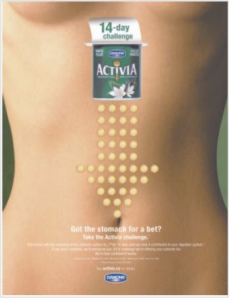In Experiencing Food and the Senses, one of the core courses in the MLA in Gastronomy program at BU, we shine a spotlight on all of the senses, especially those so often left out of scholarly inquiry. I continued my study of gender, coupling it with exploration of digestion as portrayed in advertising for Activia yogurt. Here is a taste from “Toned Tummies and Bloated Bellies: Activia Yogurt and Gendered Digestion.”

Close up of a 4-ounce Activia container, which advertises its trademark named bacterial strain, bfidius regularis. The container also includes the product’s health claim, “Helps regulate your digestive system.” The curving vertical lines mimic the female abdomen included in Activia television commercials.
Often considered a taboo topic in the United States, the promotion and popularity of Activia, a probiotic yogurt launched in the U.S. in 2006, has in some ways opened a dialogue among American women on regularity, digestion, and constipation. In studies exploring gendered perceptions of food, yogurt is often considered a feminine comestible (Kiefer et al. 2005; Jensen & Holm 1999). Furthermore, Dannon states that they have only ever marketed their products to women (Sandler, 2008). As a functional food sold to appease digestive ills, the female-focused marketing of Activia provides a new and different opportunity to analyze gender in Dannon’s marketing tactics.
Activia’s probiotic market prowess takes place within a contemporary culture of constipation. Before Activia launched in the United States, Dannon hired the Opinion Research Corporation to survey more than 20,000 Americans for the Activia Most Irregular Cities Ranking. In this survey, irregularity was defined as “that miserable experience of not going to the bathroom for two or more days” (Dannon Press Release, 2006). Extrapolated survey results indicated that 26 million Americans had experienced irregularity at least once in the last three months (Dannon Press Release, 2006).
Digestive problems appear to be gendered. While it is unclear why, many functional gastrointestinal disorders, such as irritable bowel syndrome (IBS), occur significantly more often in women (Chang et al., 2006). Bringing unexpected and painful physical symptoms, IBS also results in emotional distress over one’s lack of control over bowel habits, which may affect women more than men (Chang et al., 2006). For example, women are taught that bodily functions are something to be kept private and secret as compared to men. In addition, bloating, as a physical condition that creates the appearance of fatness, is in conflict with the Thin Ideal which reigns in Western culture.
While the medical community recognizes these social implications, Walton (2002) argues that little scholarship explores “how bowel ‘regularity’ becomes one of the means by which women exercise ‘control’ in their daily lives” (p. 57). Vidali (2010) provides one such example as she explores the rhetorics of gastrointestinal (GI) disorders from a disability studies perspective.
A historical trajectory exists for the relationship between women and digestion. In Inner Hygiene: Constipation and the Pursuit of Health in Modern Society, Whorton (2000) chronicles the “culture of constipation” that emerged in the United States, England, and Europe in the nineteenth century. While a bodily issue with health implications, constipation was also viewed as linked to “spiritual, moral, and emotional well-being” (Walton, 2002). Most poignantly, Whorton argues that the nineteenth- and twentieth-century culture of constipation “conveys people’s ambivalence about modern life” (Verbrugge, 2002, p. 76). He argues that the forces of modernity that supposedly caused digestive distress (processed diets) also fueled its scientific and technological solutions.
In her feminist reading of Whorton’s text, Walton (2002) reveals the gendered perception and treatment of constipation in the nineteenth and twentieth centuries. In particular, she reveals how the “Lane colectomy,” a surgical procedure that was performed by British surgeon Sir Arbuthnot Lane (and later found to be ineffective and harmful), targeted nearly exclusively female subjects. Lane argued that poor digestive health rendered a woman ugly, undesirable, and unmarriageable, but as Whorton so poetically states, “surgery tamed the shrew” with Lane reporting that several of his female patients were married after receiving his operation (2000, p. 69). Walton argues:
As a result of the discourse of the colon throughout the late nineteenth and early twentieth centuries, we might, to follow Foucault’s lead, say that a new ‘species’ of individual was born: the ‘abdominal woman’ (2002, p. 64).
Based upon this historical medical preoccupation, Walton argues that women continued to be targeted by campaigns promoting internal cleansing and regularity.

This sexualized image appeared in a Canadian Activia campaign. Like other advertisements, it features a woman’s flat abdomen. It also extends upward farther than most U.S. advertisements, exposing the lower curve of her breasts.
The marketing of Activia yogurt reveals a modern adaptation of the historical abdominal woman, as the female target audience is quite literally reduced to a perfectly flat abdomen. In past Activia advertisements in the United States and abroad, the focus of the ad was a woman’s toned stomach and the animated bacteria that progress in the form of a superimposed yellow arrow through her digestive system intact and ready to promote regularity, health, and vitality. Notably all of these toned tummies were and continue to be light skinned. As Vidali reveals in her analysis of Activia advertisements, these flat bare bellies provide “gastrointestinal pornography” (Brown, 2007 quoted in Vidali, 2010), sexualizing women’s bodies within the more innocuous context of health. In this way, Activia advertising promotes a sexualized view of women, a subtext of weight loss, and idealized female body standards.
Notably, while the health benefit of Activia is directly communicated as regulation of the digestive system, the product’s subtext promotes something different and far more ephemeral—vitality, an active life, and a better self. Just as nineteenth-century campaigns against constipation were equally concerned for spiritual, moral, and emotional well being, twenty-first century interest in functional and medicinal foods expresses a culture’s current concerns and hopes for the future. In this way, the marketing of Activia, functional foods, and most “healthy” foods for that matter engage in a discourse about who consumers are, who they desire to be, and the exercise of control in this process. Furthermore, as women navigate culturally constructed ideals for female bodies and behaviors, Activia both reinforces these ideals and markets itself as a technological and medicinal solution for digestive distress and bloated bellies. In this way, any and every woman can become the perfect abdomen portrayed in Activia advertisements by following a fourteen-day regimen of yogurt consumption.
References
- Chang, L., Toner, B., Fukudo, S., Guthrie, E., Locke, G. R., Norton, N., & Sperber, A. (2006). Gender, age, society, culture, and the patient’s perspective in the functional gastrointestinal eisorders. Gastroenterology, 130: 1435–1446.
- Dannon Press Release. (2006, February 15). New survey shows Americans are backed up.
- Jensen, K. O., & Holm L. (1999). Review preferences, quantities and concerns: socio-cultural perspectives on the gendered consumption of foods. European Journal of Clinical Nutrition, 53, 351-359.
- Kiefer, I., Rathmanner, T., & Kunze, M. (2005). Eating and dieting differences in men and women. The Journal of Men’s Health & Gender, 2(2), 194-201.
- Sandler, L. (2008, July 3). What health benefits, exactly, is Activia yogurt supposed to offer? Slate.
- Verbrugge, M. H. (2002). Inner hygiene: Constipation and the pursuit of health in modern society (review). Bulletin of the History of Medicine, 76(1): 171-172.
- Vidali, A. (2010). Out of control: The rhetoric of gastrointestinal disorders. Disability Studies Quarterly, 30(3/4): http://dsq-sds.org/article/view/1287/1313
- Walton, J. (2002). Female peristalsis. differences: A Journal of Feminist Cultural Studies, 13(2): 57-89.
- Whorton, J. C. (2000). Inner hygiene: Constipation and the pursuit of health in modern society. Oxford: Oxford UP.

A round of applause for your blog post.Truly thank you! Cool.
LikeLike
Thank you for your kind words and for reading!
LikeLike
Lovely to see someone call out those Activia Ads! Similar ads were appearing on Italian television over 10 years ago when I was there–forget which yogurt it was–but this kind of targeting of women’s intestinal health (for beauty and well-being) was aggressive in Italy–and probably elsewhere in Europe–before catching on in the US. Thanks for quoting from my Female Peristalsis piece, by the way. You might be interested to read a follow up article I wrote in a volume of collected essays on modernity and neurology: “Modernity and the Peristaltic Subject” in _Neurology and Modernity: a Cultural History of Nervous Systems, 1800-1950_, edited by Laura Salisbury and Andrew Shail, (Palgrave, 2010). Hard to get, though, without a university library account.
LikeLike
Thank you for reading this post, Dr. Walton! And thank you as well for your two great articles, which greatly informed my analysis of Activia yogurt and gendered digestion. I was fortunate to somehow find a proof copy of your article in Neurology and Modernity. Here is the link for other interested readers: http://www.uri.edu/artsci/eng/Faculty/files/PeristalticSubjectProofs.pdf
On another note, I see that you teach at URI. I’ll be starting my Ph.D. in American Studies at Brown this fall, and my husband and I just moved to Providence. I hope that our paths will cross!
Thank you again for your comment.
LikeLike
So funny! We will definitely have to get together. I live in Providence, though teach in southern part of the state. Sounds like we have some similar interests. In Maine for duration of the summer, but back in RI in the Fall, after I go to a modernism conference in the UK to talk about — peristalsis.
LikeLike
Enjoy your summer and the conference and yes, I would love to meet you in the fall!
LikeLike
Great post! For the first time I have a sneaking appreciation for male farting culture. The abdominal Activia advertisements are not only repressive re gender but are actually more vulgar than farting is.
LikeLike
Thank you, Jan! And I agree with you that farting is considered far more acceptable among men than women, sometimes almost as a form of expression. Women, on the other hand, are expected to remain slim (i.e. not bloated) and silent (i.e. not farting, gurgling etc.) As women’s external bodies are controlled by expectations for thinness, so are women’s insides. Both are put on display, often in objectified ways, hence the repression and vulgarity that you astutely point out.
Thank you again for reading and commenting! I so enjoy your blog as well!
LikeLike
Pingback: Publication Update! Toned Tummies & Bloated Bellies: Activia Yogurt & Gendered Digestion | Emily Contois